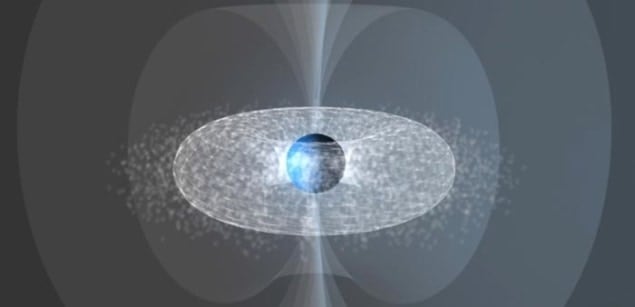
The presence of a “space wind” in the plasmasphere of the Earth has been detected for the first time, according to a physicist in France. The direct observation of this “plasmaspheric wind” – predicted theoretically more than 20 years ago – has been made by the European Space Agency’s Cluster spacecraft. The phenomenon contributes to the loss of material from our atmosphere and may play a role in regulating the intensity of the Earth’s radiation belts.
The plasmasphere is a region of the Earth’s inner magnetosphere located above the ionosphere that is a torus of dense, ionized gas. Plasmaspheric wind was initially proposed by Joseph Lemaire and Robert Schunk in 1992. The phenomenon is caused by an imbalance in the three forces that act in the plasmasphere: the gravitational attraction of the Earth’s mass, the centrifugal force caused by its rotation, and the pressure exerted by the plasma. The wind results in a steady movement of material out of this region into the upper magnetosphere – calculations showed it to be transporting around 1 kg of plasma every second, at speeds exceeding 5000 km per hour.
Blowing in the wind
As it slowly empties, the plasmasphere is filled by material from the underlying ionosphere. As such, the plasmaspheric wind plays an important role in atmospheric escape. Previously, transport of material out of the plasmasphere had only been observed in extreme conditions, when the Earth’s magnetic field was disrupted by energetic particles coming from the Sun.
Measurements of this elusive space wind were obtained by the Cluster Ion Spectrometry experiment using the highly sensitive instrumentation aboard the four orbiting Cluster II spacecraft. “We now have experimental evidence that the plasmasphere is not in an equilibrium state, even during periods without geomagnetic storms,” says physicist Iannis Dandouras, from the Centre National de la Recherche Scientifique (CNRS) and the University of Toulouse, France. He told physicsworld.com that “The plasmasphere continuously blows out a weak but steady wind, supplying ionized material to the outer magnetosphere.”
Steady flux
A special operating mode for the sensors enabled detection of ions at very low energies. By filtering out noise within the plasma data, Dandouras was able to reveal the steady flux of material away from the Earth. Analyses were made of the ion data across a variety of timeframes and different magnetospheric conditions to confirm that the wind is indeed a persistent phenomenon.
The plasma stored in this orbital region also plays a vital role in controlling the energy balance of the Earth’s radiation belts. It is also responsible for causing delays in the propagation of global-positioning-system signals that pass through the plasmasphere.
“The plasma density in the region of space surrounding the Earth is of considerable interest,” says Tim Yeoman, a physicist at the University of Leicester who was not involved in this study. He explains that the origin of this plasma was traditionally considered in terms of photoionized atmospheric particles escaping along the Earth’s magnetic field, and the transport of ions across the boundary between the terrestrial and solar magnetic fields through magnetic reconnection. “Here, new observational evidence is provided of the transport of ions originating in the inner regions of the Earth’s magnetic field across the magnetic field to the outer magnetosphere – a potentially important new process contributing to the balance between plasma sources and sinks within the Earth’s magnetosphere,” he says.
Other studies of magnetospheric phenomena are already in progress. “Following the recent launch of the Van Allen probes, we now have more satellites flying in the magnetosphere,” Dandouras says, explaining that this will allow a greater range of simultaneous measurements across this region, which may be used for future analysis.
The work is published in Annales Geophysicae.



